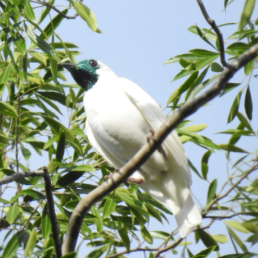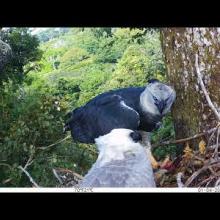

Join BirdNote tomorrow, November 30th!
Illustrator David Sibley and actor H. Jon Benjamin will face off in the bird illustration battle of the century during BirdNote's Year-end Celebration and Auction!
Harpy Eagles spend their lives in tall, remote tropical forests in Central and South America, flying from tree to tree in search of food. The eagles are named for the Harpies of Greek mythology, women with the bodies of birds who, on Zeus’s command, snatched people from the earth. Since it takes many months for a nestling to mature, Harpy Eagles raise a youngster just once every two or three years.
Listen to this episode in Spanish here.
BirdNote®
Harpy Eagle
Written by Bob Sundstrom
This is BirdNote.
(Harpy Eagle, male song, https://www.xeno-canto.org/20069, 0.05-.11]
If there is a single bird that captures the imagination of birders it may be the Harpy Eagle.
Harpy Eagles are huge, powerful hunters that spend their lives in tall, remote tropical forests in Central and South America. Named for the Harpies of Greek mythology, gruesome women with the bodies of birds, these eagles fly from tree to tree in search of food, rarely venturing into the open sky above.
(Harpy Eagle call, https://www.xeno-canto.org/384930, 0.00-.07)
Feathered in varying shades of gray with a white belly, the Harpy has a strong hooked beak, and distinctive tall feathers that stand out straight from its head.
Harpy Eagles are massive. Females, larger than males, are three and a half feet long and weigh up to 20 pounds. That’s heavier than the largest Bald Eagle. Their rear talons measure a full five inches, ideal for plucking sloths and monkeys from the trees.
Harpy Eagles may not be the Hounds of Zeus, but they are legendary in their own right. However, human persecution and ongoing cutting of forest are threatening these eagles, who raise just one nestling every two or three years.
So each one is precious — and spectacular.
(Harpy Eagle, male song, https://www.xeno-canto.org/20069, 0.05-.11]
For BirdNote, I’m Michael Stein.
###
Senior Producer: Mark Bramhill
Producer: Sam Johnson
Managing Editor: Jazzi Johnson
Content Director: Jonese Franklin
Bird sounds provided by Xeno-canto. Recorded by David Edwards and Dušan M. Brinkhuizen.
BirdNote’s theme music was composed and played by Nancy Rumbel and John Kessler.
© 2018 Tune In to Nature.org August 2018/2019 January 2025 Narrator: Michael Stein
ID# HARHAR-01-2018-08-07 HARHAR-01




